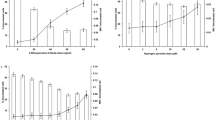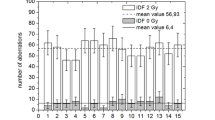Abstract
The well-known action of caffeine in synergizing mutagenesis (including chromosome aberrations) of agents like ionizing radiation by inhibition of cellular repair processes has been incorporated into a rapid procedure for detection of mutagenicity with high sensitivity. Effects of 5–10 rads of γ-irradiation, which approximate the human lifetime dose accumulation from background radiation, can be detected in a two-day procedure using an immortalized human WBC culture. Chromosomally visible lesions are scored on cells incubated for 2 h after irradiation in the presence and absence of 1.0 mg/ml of caffeine. An eightfold amplification of scorable lesions is achieved over the action of radiation alone. This approach provides a closer approximation to absolute mutagenicity unmitigated by repair processes, which can vary in different situations. It is proposed that mutagenesis testing of this kind, using caffeine or other repair-inhibitory agents, be employed to identify mutagens in their effective concentrations to which human populations may be exposed; to detect agents such as caffeine that may synergize mutagenic actions and pose epidemiologic threats; and to discover effective anti-mutagens. Information derived from the use of such procedures may help prevent cancer and newly acquired genetic disease.
Similar content being viewed by others
Literature cited
Bishop, M.J. (1987).Science 235305–311.
Rowley, J.D. (1990).Cancer Res. 503816–3825.
Croce, C.M. (1991).Cancer Res. (Suppl 515105–5108.
Sager, R. (1989).Science 2461406–1412.
Li, A.P., and Loretz, L.J. (1991). InGenetic Toxicology (eds.) Li, A.P., and Heflich, R.H. (CRC Press, Boca Raton), pp. 119–141.
Cellular Systems for Toxicity Testing, Vol. 407. (1983). (New York Academy of Sciences, New York).
Environmental Health Criteria 51: Guide and Short Term Tests for Detecting Mutagenic and Carcinogenic Chemicals. (1985). (World Health Organization, Geneva). pp. 1–208.
Banbury Report 28. Mammalian Cell Mutagenesis. (1987). (Cold Spring Harbor Laboratory, New York).
Ames, G.N. (1971). InChemical Mutagens: Principles and Methods for Detection, Vol. 1 (ed.) Hollander, A. (Plenum Press, New York), pp. 267–288.
Waldren, C.A. (1983). InChemical Mutagens, Vol. 8 (ed) de Serres, F. (Plenum Press, New York).
Preston, R.J. (1984). InSingle-Cell Mutation Monitoring Systems: Methodologies and Applications (eds.) Ansari, A.A., and deSerres, F.J. (Plenum, New York).
Puck, T.T., and Waldren, C.A. (1987).Somat. Cell Mol. Genet. 13405–409.
Waldren, C.A., Jones, C., and Puck, T.T. (1987).Somat. Cell Mol. Genet. 13411–414.
Puck, T.T. (1985).Lett. Math. Phys. 10225–230.
Kihlman, B.A. (1977).Caffeine and Chromosomes. (Elsevier, Amsterdam).
Thompson, L.H., and Hoy, C.A. (1986). InChemical Mutagens: Principles and Methods for Their Detection, Vol. 10 (ed.) de Serres, F.J. (Plenum Press, New York), pp. 285–325.
Natarjan, A.T., Obe, G., and Dulout, F.N. (1980).Hum. Genet. 54183–189.
Pincheira, J., and Lopez-Saez, J.F. (1991).Mutat. Res. 25171–77.
Bender, M.A. (1957).Science 126974.
Puck, T.T. (1958).Proc. Natl. Acad. Sci. U.S.A. 44772–780.
Kihlman, B.A., and Andersson, H.C. (1985).Mutat. Res. 150313–325.
Jelmert, O., Hanstein, I.L., and Langard, S. (1992).Mutat. Res. 271(3):289–298.
Pellicia, F., and Rocchi, A. (1992).Mutat. Res. 28243–48.
Sakamoto-Hoto, E.T., and Takahashi, C.A. (1991).Mutat. Res. 248(1):195–202.
Waldren, C.A. (1983). InChemical Mutagens: Principles and Methods for Their Detection, Vol 8, (ed.) de Serres, F.J. (Plenum, New York), pp. 235–260.
Timson, J. (1977).Mutat. Res. 471–52.
Hansson, K., Palitti, F., Kihlman, B.A., and Karlsson, M.B. (1982).Hereditas 9751–58.
Kihlman, B.A. (1977).Caffeine and Chromosomes, (Elsevier, Amsterdam).
Kihlman, B.A., and Andersson, H.C. (1986). InGenetic Toxicology of Environmental Chemicals, Part A: Basic Principles and Mechanisms of Action. (eds.) Ramel, C., Lambert, B., and Magnusson, J. (Alan R. Liss, New York), pp. 395–402.
Natarajan, A.T., van Zeeland, G., Palitti, A.A., Meijers, F., and Verdegaal-Immerzeel, E.A.M. (1980).Hum. Genet. 54183–189.
Lialiaris, T., Pantazaki, A., Sevridis, E., and Mourelatos, D. (1992).Mutat. Res. 265(2):155–163.
Blagoeva, P.M., Ralansky, R.M., and Mircheva, R.J. (1991).Mutat. Res. 246(1):123–127.
Waldren, C.A., Uevo, A., Vannais, D., Bedford, J.S., and Hei, T. (1992). InLow Dose Irradiation and Biological Defense Mechanisms, (eds.) Sugahara, T., Sagan, L.A., and Aoyama, T. (Elsevier, Amsterdam), pp. 339–342.
Walters, R.A., Gurley, L.R., and Tobey, R.A. (1974).Biophys. J. 1499–118.
Tolmach, R.J. (1980).Radiat. Res. 123119–137.
Timson, J. (1987).Mutat. Res. 471–52.
Waldren, C.A., and Rasko, I. (1978).Radiat. Res. 7395–110.
Puck, T.T., and Marcus, P.I. (1956).J. Exp. Med. 103653–666.
Waldren, C.A., Correll, L., Soignier, M.A., and Puck, T.T. (1986).Proc. Natl. Acad. Sci. U.S.A. 834839–4843.
Waldren, C.A., and Puck, T.T. (1987).Somat. Cell Mol. Genet. 13411–414.
Puck, T.T., and Waldren, C.A. (1987).Somat. Cell Mol. Genet. 13405–409.
Evans, H.J. (1983).Ann. N.Y. Acad. Sci. 407131–141.
Author information
Authors and Affiliations
Rights and permissions
About this article
Cite this article
Puck, T.T., Morse, H., Johnson, R. et al. Caffeine enhanced measurement of mutagenesis by low levels of γ-irradiation in human lymphocytes. Somat Cell Mol Genet 19, 423–429 (1993). https://doi.org/10.1007/BF01233247
Received:
Issue Date:
DOI: https://doi.org/10.1007/BF01233247




